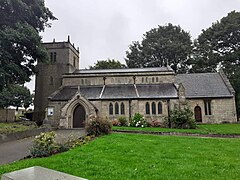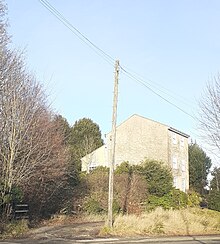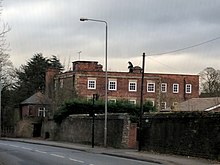Skegby
| Skegby | |
|---|---|
 Skegby – St Andrew's Church | |
Location within Nottinghamshire | |
| OS grid reference | SK492610 |
| District | |
| Shire county | |
| Region | |
| Country | England |
| Sovereign state | United Kingdom |
| Post town | SUTTON-IN-ASHFIELD |
| Postcode district | NG17 |
| Dialling code | 01623 |
| Police | Nottinghamshire |
| Fire | Nottinghamshire |
| Ambulance | East Midlands |
| UK Parliament | |
Skegby is a village in the Ashfield district of Nottinghamshire, England. It lies on the B6014 road, two miles west of Mansfield and one mile north of Sutton-in-Ashfield, close to Stanton Hill. Skegby sits on both sides of a deep valley near the source of the River Meden. It was a civil parish until 1935, when it was absorbed into Sutton-in-Ashfield.
History
The name of Skegby has a similar origin to the name of Skegness – originating from a Dane named Skeggi ("bearded one"). Skegby is mentioned in the Domesday Book as "a berewick of the King's manor at Mansfield". Skegby manor house (which is now in ruins) is located on Mansfield Road. In 1223 Godfrey Spigurnal became Lord of the Manor of Skegby. His descendants held the estate until 1334 when Elizabeth Spigurnal, who married Thomas Gobion, disposed of it to Richard Pensax. His descendant passed it to Percival Lindley in 1450 which was the beginning of the three hundred-year tenure of the Lindley family as Lords of the Manor. The estate passed to John Dodsley in 1820 and the Dodsley family remained in Skegby until the 1930s. The last Manorial Court was held in Skegby Hall on 25 April 1924. The current Lord of the Manor is Dominic Vernon Dodsley Williams, who currently resides in Carmarthenshire.[citation needed]
Francis White's "Directory of Nottinghamshire," of 1853 tells us that Skegby had "an extensive coal mine, and several limestone quarries and kilns" and that in the 1800s "stocking-making was a common occupation." According to White, Skegby celebrated its Village Feast on the Sunday after 10 July.[1]
The Anglican church was built in the Norman period, prior to 1571 and was formerly a chapelry to Mansfield. The church was restored and enlarged in 1870. In 1844 a Wesleyan Methodist chapel was built, with a "Free Church" being built in 1863. In 1865 a National School for both boys and girls was built in Skegby village and a Baptist chapel was built in 1877.
Skegby was an ancient parish. It covered about 1,433 acres and included the then hamlet of Stanton Hill.[2] In 1931 the parish had a population of 6,519.[3] It was in Skegby Rural District. On 1 April 1935 the parish was abolished and merged with Sutton in Ashfield and became part of Sutton in Ashfield Urban District.[4] Sutton in Ashfield Urban District was in turn abolished in 1974 to become part of the new district of Ashfield.[5]
Areas of interest



Several old buildings and features can be found in Skegby, including the Pinfold on Mansfield Road, which dates from the 18th century, the Troughs on Old Road, which are thought to be over 200 years old, the 17th century Quaker House on Mansfield Road, the 16th century Kruck Cottage and Skegby Hall, which was built in 1720 on the site of a much earlier dwelling.
The Skegby Heritage Trail, (not to be confused with the Skegby Trail), which takes in places of historical interest around the village of Skegby, including Skegby Hall Gardens[6] (currently under restoration), and the Manor House, was launched in October 2009 by the Skegby Appreciation Society. The heritage trail included nine sites in Skegby, such as the 13th Century Skegby Manor House, 16th Century Kruck Cottage and the 17th Century Quaker House.[7]
The Quaker House is linked to Elizabeth Hooton, one of the founders of the Quakers movement in the United Kingdom. Elizabeth is said to be the first woman Quaker.[8][9] It is here that Elizabeth met George Fox founder of the Quakers.[10]
The Skegby Trail is a former railway track used by cyclists as an off-road track and as a nature trail by walkers which can be accessed from Buttery Lane in Skegby and ends at Chesterfield Road in Pleasley. From this trail the Teversal Trails, which form part of the Pleasley Trails Network may be accessed via the Link Trail between Skegby and Teversal.
Skegby Hall

Skegby Hall was built for the Lindley family in 1720. It was Grade II listed in 1988.[11] After private residential ownership, it was used from the late 1940s as an approved school for boys, later becoming a care home with education.[12][13] It was converted into residential flatlets in 1992. It gained notoriety in the 2000s after multiple allegations of child abuse, with police investigations Daybreak, launched in 2010, followed by Xeres in 2014.[14][15][16][17]
Modern Skegby
Skegby has a number of small shops, off-licences, take away food outlets, hair salons and a petrol station. Other amenities which can be found in Skegby include a small library which is shared with the nearby village of Stanton Hill and the Woodside Medical Surgery and Pharmacy.
There are three public houses in Skegby: the Forest Tavern and the Rifle Volunteer, both on Forest Road and the Fox & Crown on Dalestorth Road. The Maypole on Dawgates Lane closed in June 2023 and the new owners plan to convert it into a residential dwelling.[18] The Triple S Snooker and Social Club is on Mansfield Road.
Schools
Skegby has three primary schools: Healdswood Infant and Nursery School on Barker Avenue, Skegby Junior Academy on Ash Grove and St. Andrew's C of E Primary School on Mansfield Road. St. Andrew's C of E Primary School was originally a National School built in 1865 on land donated by Lady Carnarvon and that year had 95 pupils under the tutelage of one schoolmaster.[19]
Churches
St Andrew's Church is the Church of England parish church. Skegby Methodist Church is on Mansfield Road.
See also
References
- ^ F. White "Directory of Nottinghamshire" (Sheffield, 1853)
- ^ "Skegby". GENUKI. Retrieved 26 December 2020.
- ^ "Population statistics Skegby Ch/CP through time". A Vision of Britain through Time. Retrieved 26 November 2021.
- ^ "Relationships and changes Skegby Ch/CP through time". A Vision of Britain through Time. Retrieved 26 December 2020.
- ^ "The English Non-metropolitan Districts (Definition) Order 1972", legislation.gov.uk, The National Archives, SI 1972/2039, retrieved 31 May 2023
- ^ "MNT26724 - Grounds at Skegby Hall - Nottinghamshire Historic Environment Record". her.nottinghamshire.gov.uk. Retrieved 28 April 2024.
- ^ "Heritage Trail". www.skegbyappreciationsociety.co.uk. Retrieved 28 April 2024.
- ^ Manners, Emily. Elizabeth Hooton, First Quaker Woman Preacher. (London: Headley Brothers, 1914)
- ^ "Elizabeth Hooton – Notable Women Ancestors". Rootsweb.ancestry.com. Retrieved 8th February 2023
- ^ Percy Livingstone Parker, George Fox’s Journal 1903 retrieved on the 6th February 2023
- ^ Historic England. "Skegby Hall (1275915)". National Heritage List for England. Retrieved 28 April 2024.
- ^ Community Homes with Education (CHEs) childrenshomes.org Retrieved 8 May 2022
- ^ Skegby Hall, Sutton in Ashfield, Nottinghamshire childrenshomes.org Retrieved 8 May 2022
- ^ "Protest over care home abuse claims". Chad, 5 November 2014, p.8 Accessed 8 June 2022
- ^ Pensioner describes Skegby Hall abuse ordeal Hucknall Despatch, 30 September 2014. Retrieved 8 May 2022
- ^ These are the 22 children's homes being investigated by Nottinghamshire Police over abuse allegations Nottinghamshire Live, 5 September, 2018. Retrieved 8 May 2022
- ^ Accused man (87) in historic sex abuse trial at Skegby Hall faced allegations at the time Chad, 29 September 2021. Retrieved 8 May 2022
- ^ Hartley, Joshua (3 April 2024). "Pub will not reopen as new plans submitted to turn it into something different". Nottinghamshire Live. Retrieved 28 April 2024.
- ^ The Nottinghamshire Village Book. Countryside Books and the Nottinghamshire Federation of Women's Institutes. 1989. p. 143. ISBN 978-1-85306-057-1.
- White's "Directory of Nottinghamshire," 1853
- The story of Skegby and Stanton Hill, by W Clay-Dove, 1984

